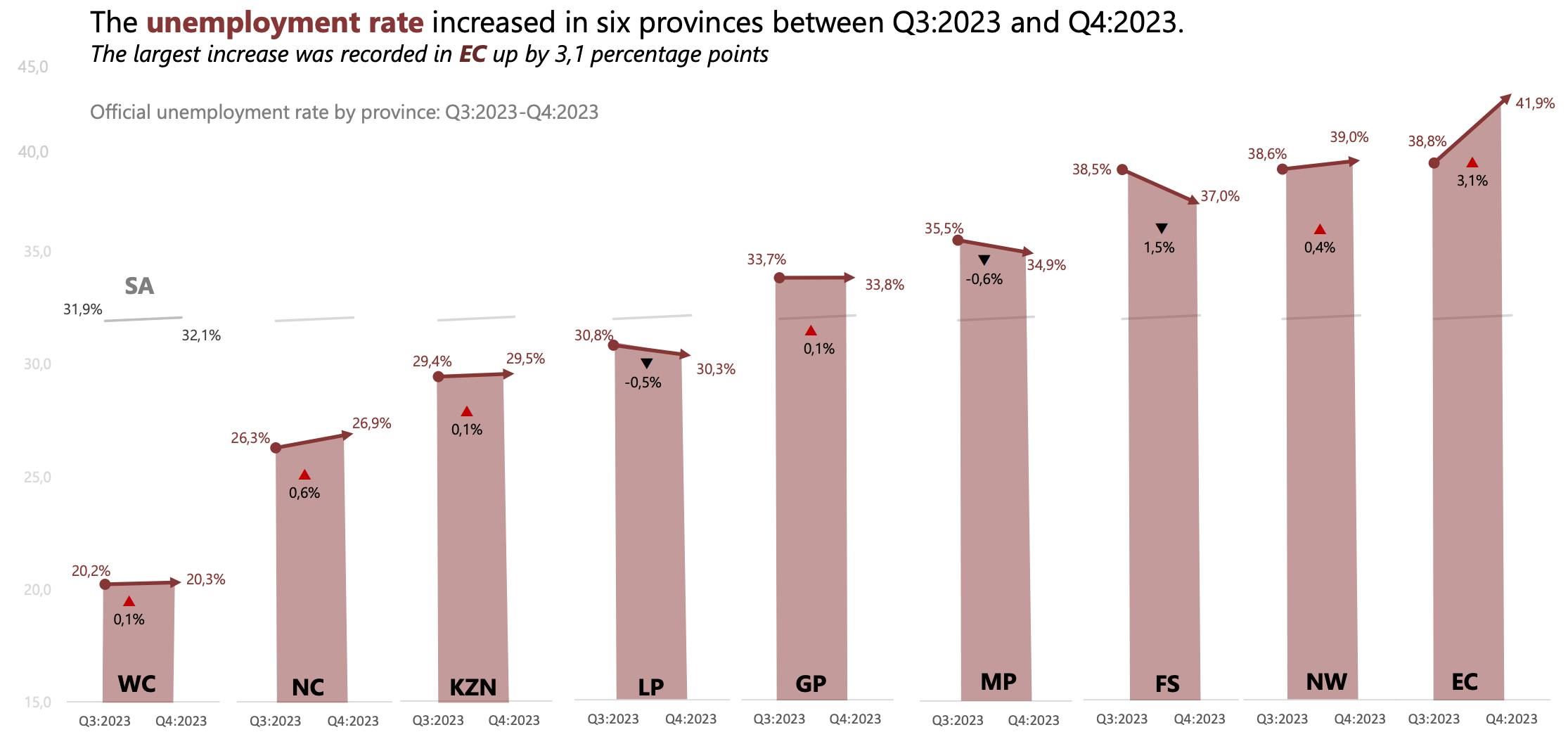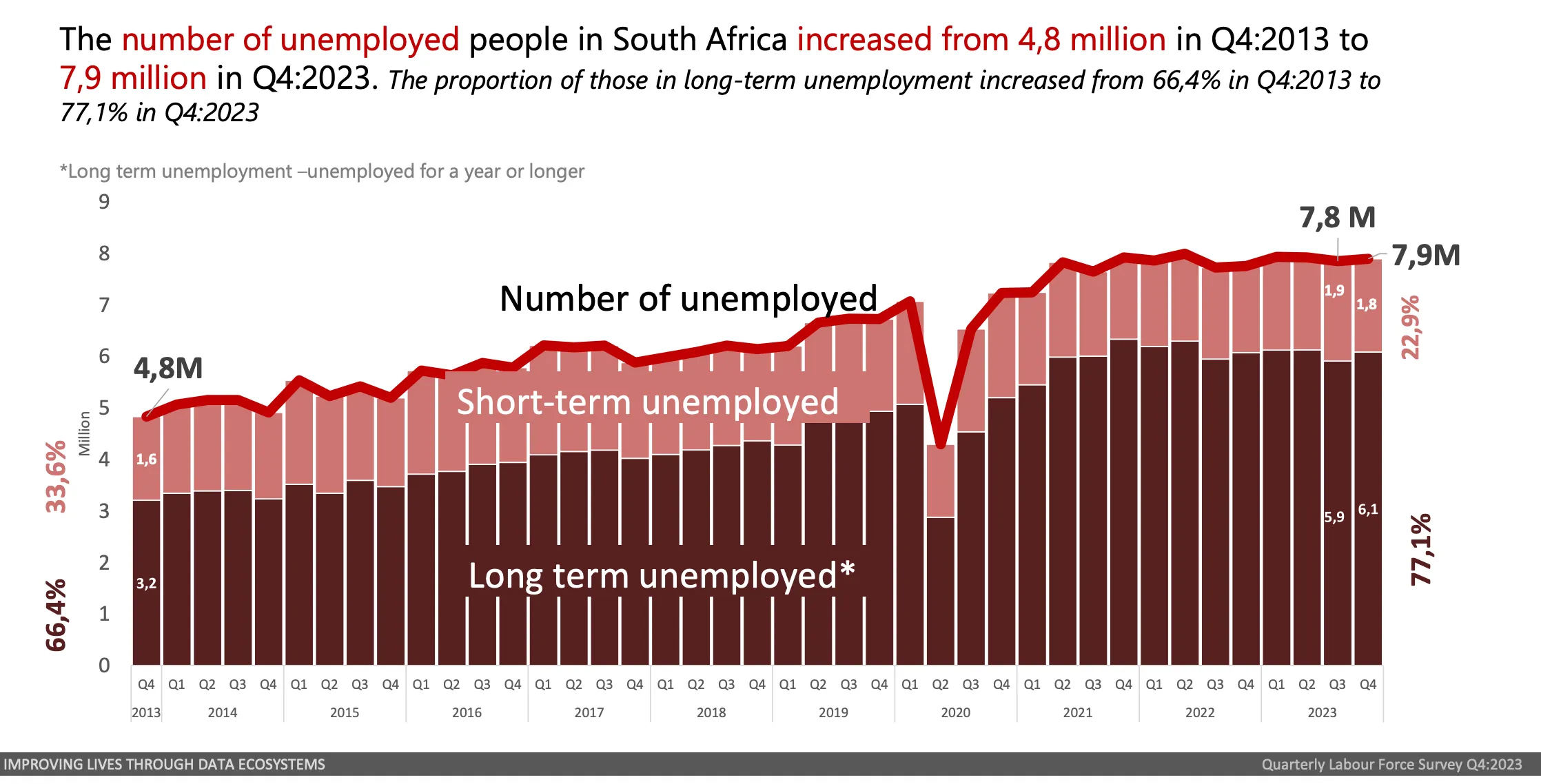QUARTERLY LABOUR FORCE SURVEY
Economic crisis — SA unemployment rate edges up to 32.1% in Q4 2023

South Africa’s unemployment rate edged up to 32.1% in the fourth quarter of last year from 31.9% in the previous quarter. Pointedly, after employment increased for eight consecutive quarters, the last three months of 2023 saw a net total of 22,000 jobs shed. And the number of unemployed South Africans has almost doubled in a decade.
The data, unveiled on Tuesday by Statistics South Africa (Stats SA), may be the last Quarterly Labour Force Survey (QLFS) before the general elections. The ruling African National Congress (ANC) will no doubt point to the eight straight quarters of job growth that preceded the Q4 2023 read.
But the general trend has simply been woeful. In a presentation accompanying the data release, Stats SA said that the number of unemployed South Africans had swelled to 7.9 million in Q4 2023 from 4.8 million in Q4 2013 — an increase of over 80% over the course of a decade.
Let that sink in. A decade ago South Africa’s unemployment crisis was regarded as a tragedy when 4.8 million people were counted as unemployed. That number now stands at almost 8 million.
And over that period the proportion of those mired in long-term unemployment rose to 77.1% from 66.4%.
No amount of lipstick is going to make this pig presentable.
The number of people fortunate enough to have a job stands at 16.7 million, but that is out of a working-age population (between 15 and 64) of 41.0 million. The labour force itself stands at 24.6 million with 16.4 million people counted as “not economically active”.
And if the unemployment line keeps on growing, poverty and inequality are sure to rise. The economic crisis rooted mostly in a trifecta of woes — power, logistics and crime — dramatically adds to the other terrible trio of unemployment, poverty and glaring disparities of wealth, income and opportunity.

The number of unemployed people in South Africa increased from 4.8 million in Q4:2013 to 7.9 million in Q4:2023. The proportion of those in long-term unemployment increased from 66.4% in Q4:2013 to 77.1% in Q4:2023. (Graph: Supplied)
Total employment decreased by 22,000 in Q4 2023 compared to Q3. The labour-intensive construction sector and agricultural sectors shed 108,000 jobs and 35,000 jobs respectively.
The mining sector added 37,000 jobs on a quarterly basis, but that trend seems unlikely to hold as platinum producers and those of other commodities embark on job cuts.
The expanded definition, which includes discouraged job seekers, was largely unchanged at 41.1%.

There is little light at the end of this tunnel, not least because of Eskom’s inability to keep the lights on.
South Africa’s economy may have narrowly dodged a recession in Q4 2023 after contracting 0.2% in the previous three-month period on a quarterly basis, but no big rebound is seen.
Forecasts for South African economic growth for 2024 range from 1.0% to 1.5%, a pace that economists say cannot generate job creation on the scale that is required.
“Decimal changes to South Africa’s unemployment rate are reflective of a stagnant economy. Indeed, GDP in Q3 2023 was little changed from pre-pandemic levels (Q1 2020), indicating that the South African economy has not gone anywhere in the past three years — this is not expected to change in the near term,” Jee-A van der Linde, Senior Economist at Oxford Economics Africa, said in a commentary on the data.
“A lack of infrastructure investment over the years has limited economic growth potential, which means the economy is unable to produce enough jobs to satisfy demand.” DM

















 Become an Insider
Become an Insider
You ANCn nothing yet.
Given the chance this government will drive South Africa into the ground.
We have 16.7 million working out of 69.67m population (UN estimate) So every person working is supporting just under 4 other persons. Out of the 16.7 roughly 30% are “government” employees, so that leaves 11.69m doing the actual work. Or one working adult supporting 6 people And over 55 000 government employees are earning over a million Rand per annum adding to the burden of the 11.69 who are on average earning less than R300 000 pa